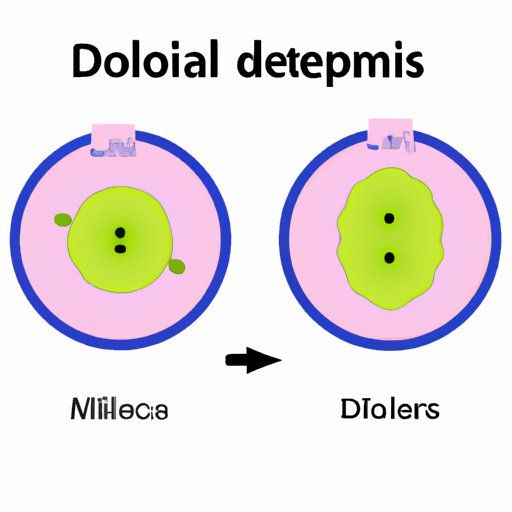Introduction
The term “diploid” refers to a normal cell containing two complete sets of chromosomes, with one set inherited from each parent. Meiosis, on the other hand, is a critical process that ensures the faithful distribution of genetic material during cell division, leading to the formation of sex cells or gametes.
Diploid cells are necessary for meiosis to occur in sexual reproduction. They are responsible for the creation of haploid cells, which contain only one set of chromosomes and can combine with another haploid cell during fertilization to form a diploid zygote.
Understanding Diploid Cells in Meiosis
Meiosis takes place in two distinct phases- meiosis I and meiosis II. During each of these stages, diploid cells undergo a series of intricate processes.
Meiosis I begins with the division of the diploid cell into two haploid cells. The homologous pairs of chromosomes exchange genetic materials through a process known as crossing over. As a result, the newly created haploid cells have a different genetic makeup compared to the original diploid cell.
Meiosis II then follows, with each haploid cell further dividing into two cells, each with a single set of chromosomes. Thus, four haploid cells are formed, each with unique genetic content, which can contribute to genetic variation.
The Unique Features of Diploid Cells in Meiosis
Diploid cells have several unique features that make them significant players in meiosis.
Homologous chromosomes are paired chromosomes that contain similar genes, but with an allele that differs between the maternal and paternal chromosomes. These homologous chromosomes come together during crossing over, where they exchange genetic material and create genetic diversity.
Recombination strengthens the genetic diversity, and it occurs when the newly formed haploid cells contain a different arrangement of alleles due to the exchange of genetic material during meiosis.
Independent assortment is where different pairs of homologous chromosomes assort independently of each other, contributing to still more genetic diversity. This process occurs during anaphase l of meiosis, where the direction in which the chromosomes separate is completely random and independent of one another.
The combination of these processes promotes genetic variation that helps in the evolution of species.
The Role of Diploid Cells in Meiosis
Diploid cells are fundamental to the formation of gametes in sexual reproduction. The fusion of haploid cells, the sperm from the male and the egg from the female, results in the formation of a new diploid organism. The changes that occur during meiosis provide a necessary source of genetic diversity.
During fertilization, the unique set of chromosomes from the sperm and egg results in a new individual that possesses a unique combination of characteristics derived from each parent. Furthermore, meiosis is responsible for problems such as chromosomal abnormality that can cause offspring to inherit genetic disorders from their parents.
Unlocking the Mystery: The Challenges of Understanding Diploid Cells in Meiosis
Although meiosis is a well-understood process, several common misconceptions and misunderstandings still persist. For instance, many people believe that during reproduction, offspring inherit qualities equally from their parents.
However, many factors can affect the inheritance of genes, such as the environmental influence on phenotype and the nature of the relationship between genotype and phenotype. These interactions often make it challenging to predict an offspring’s characteristics.
Additionally, genetic inheritance is often highly complex and can result in offspring inheriting several different versions of a trait. It is essential to understand these nuances when trying to comprehend meiosis and genetic inheritance.
Meiosis Demystified: A Focus on Diploid Cells
There are many examples of diploid cells, including human somatic cells and animal cells like those found in fish, amphibians, and reptiles.
Meiosis has several practical applications in medicine, biotechnology, and other fields. For instance, understanding meiosis and genetic diversity can aid in diagnosis, treatment, and management of genetic disorders such as sickle cell anemia and muscular dystrophy. Genetic engineering, which involves the alteration of genetic material to treat or prevent disease, may also be facilitated by understanding meiosis and the genetic makeup of organisms at the cellular level.
Conclusion
As the article has discussed, diploid cells play an essential role in meiosis and contribute to genetic diversity, making them a crucial element in sexual reproduction. Forming a clear understanding of their function in meiosis can be challenging, but it is vital for comprehending how genetic diversity arises. Encouraging more research in this area can help to unlock the full potential of meiosis and diploid cells in medicine and biotechnology.
